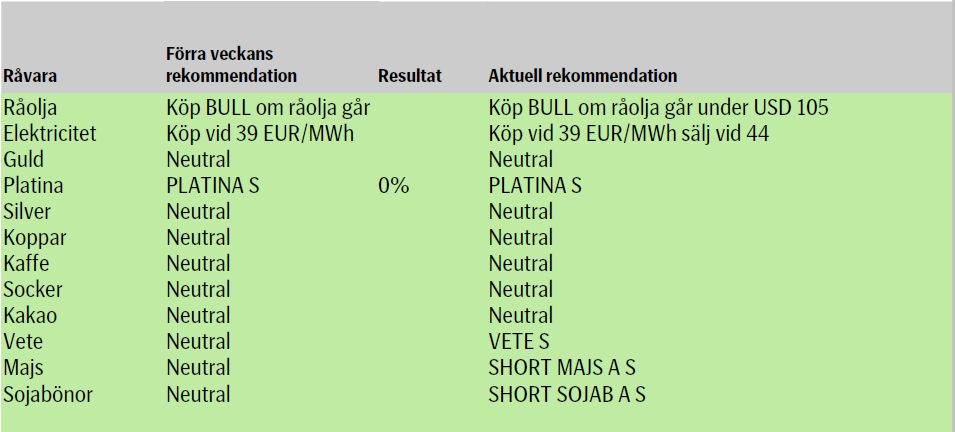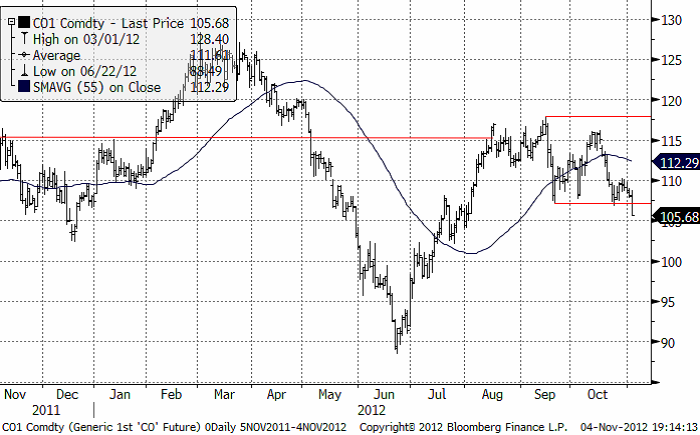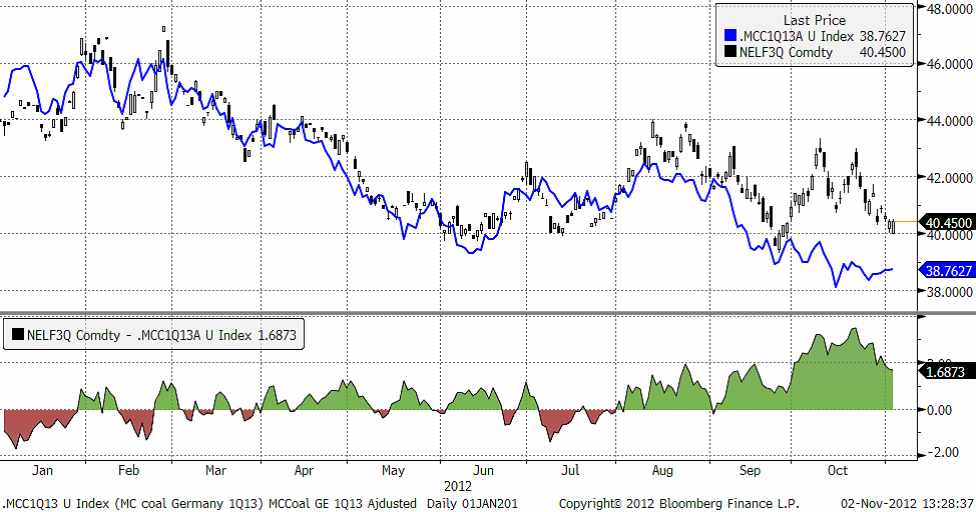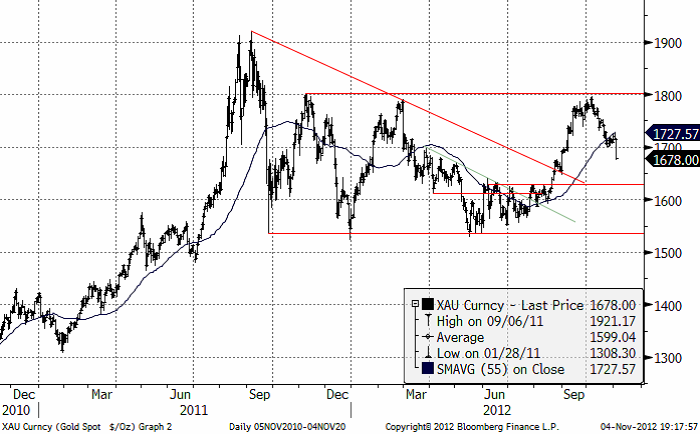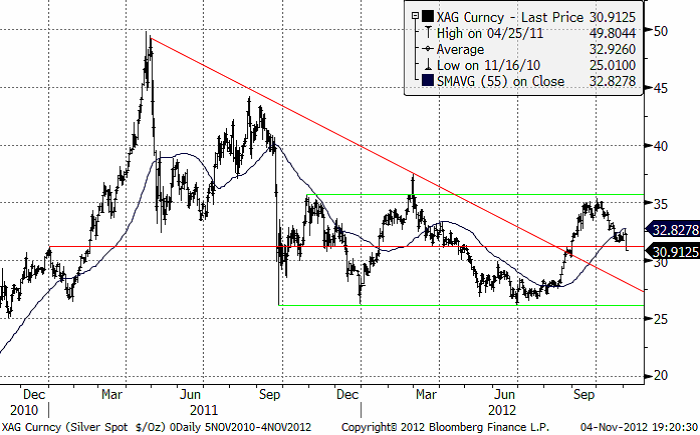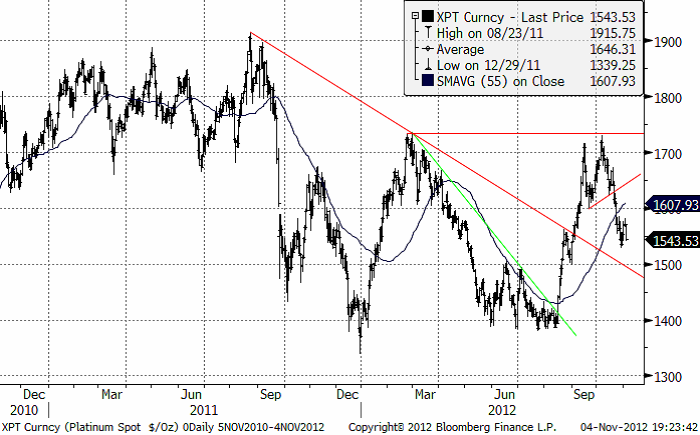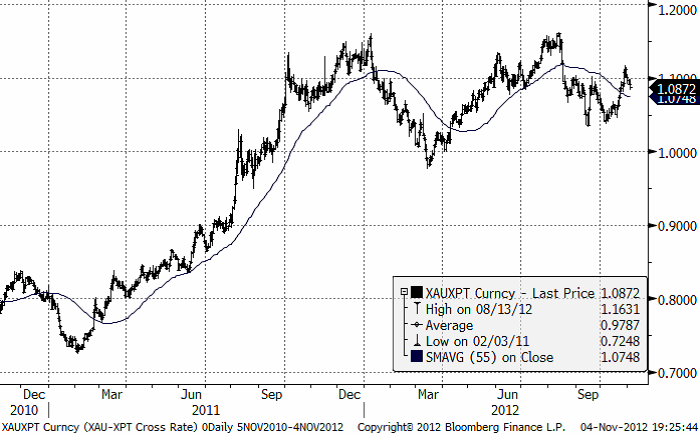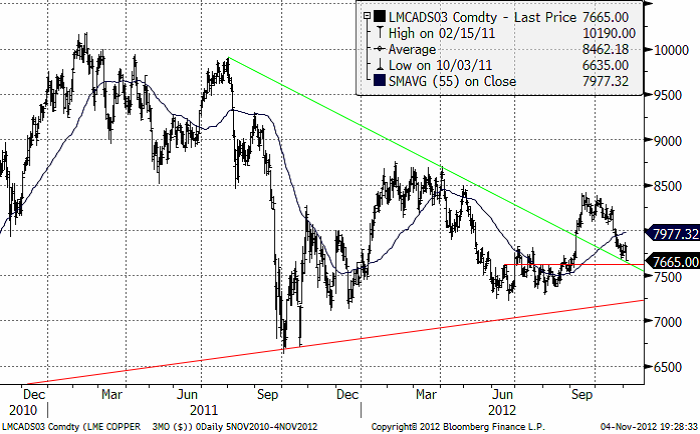Analys
SEB – Råvarukommentarer, 5 november 2012
Sammanfattning av rekommendationer
Råolja – Brent
Vi fortsätter rekommendera köp av Bull Olja och Olja S vid nedgång på Brent kring $105/fat. Vi bedömer det som osannolikt att priset på råolja kommer att rasa lägre än så, såvida inte tillväxtprognoserna skrivs ned väsentligt. Vår uppfattning är att oljepriset kommer att fortsätta vara väl understött med tanke på stora geopolitiska risker, strama marknader för oljeprodukter, höga incitamentpriser för att stimulera till tillräckliga investeringar i ny kapacitet och behovet av att producentländer försvarar priser för att balansera budgetar.
Medan balansen på råoljemarknaden förbättrats något är situationen för mellandestillat fortsatt mer ansträngd. Lagren av mellandestillat är historiskt låga och en kallare än normal vinter kan komma försvåra situation ytterligare. Även under normala omständigheter har raffinaderierna problem att producera tillräckligt med mellandestillat under uppvärmningssäsongen. Det gör förråden till en nyckelfaktor för balanseringen av marknaden. Den långsiktiga strukturella balansen för marknaden för mellandestillat är också oroande eftersom det är där vi ser den enda konsumtionstillväxten i Europa.
Det som dominerat nyhetsflödet i veckan är stormen Sandy, vars framfart lett till stor förödelse, både mänskligt och materiellt. Kostnaden för Sandy beräknas nu vara uppe i 50 mdr dollar. Två tredjedelar av raffinaderierna på den amerikanska östkusten, den största oljeledningen, de flesta större hamnar samt vägar och flygplatser stängdes som en följd av Sandy. Efterfrågan minskade därmed på råolja, vilket pressat priset något. Rörelserna har ändå varit begränsade och råoljepriset ganska stabilt mellan 108 och 110 usd. För oljeprodukter, inte minst bensin, har Sandy istället lett till stora uppgångar, eftersom utbudet minskat då raffinaderikapaciteten minskat och människor hamstrat drivmedel.
Iran som är starkt pressat av sanktionerna mot landet har hittills inte gett efter för trycket från omvärlden men Irans försvarsminister uppges nu ha sagt att man inte har några planer på att stänga den vitala farleden genom Hormuzsundet då ”dessa två frågor (stängning av Hormuzsundet och sanktioner mot landet) är helt oberoende och inte relaterade till varandra”.
Vår rekommendation förblir att köpa BULL OLJA X4 S eller OLJA S om priset faller ned mot 105 dollar. På den nivån ser vi goda möjligheter att tjäna pengar.
Elektricitet
Förra veckan sänkte vi vår ingångsnivå för longa positioner till €39/MWh för Q1-2013-kontraktet på Nord Pool. Motivet var att marginalkostnaden för kolkraftproduktion fortsatt falla. Vi rekommenderar att handla kontraktet från köpsidan under november om denna utgångsnivå uppnås. Å andra sidan är €43/MWh till €44/MWh bra utgångspunkter för de som tar risken att handla vinterkontraktet NELFQ3 från säljsidan med BEAR EL X2 S eller med BEAR EL X4 S.
Situationen sedan förra veckan är i stort oförändrad. Det totala hydrologiska överskottet är 10-13 TWh över normalt samtidigt som kärnkraften har god tillgänglighet. Vi har därför länge argumenterat för att differensen mellan NELF3Q och vårt MCCP-index (.MCC1Q13) varit alltför stor. Nu har så en korrigering skett och differensen minskat en del. Q1-2013-kontraktet (NELF3Q) har, i takt med lägre marginalkostnad för kolkraft och fortsatt nederbördsrikt väder, pressats lägre och är senast omsatt på €40,50/MWh. Kontraktet har ändå lite ytterligare fallhöjd och ska, i rådande miljö, närma sig €39/MWh nivån innan vi tycker att kontraktet är köpvärt.
Ska man sammanfatta elmarknaden, så är det att det stora prisfallet tycks vara över. Marknaden handlar ”sidledes” med 44 euro som övre gräns. Nu har vi sänkt den nedre gränsen till 39 euro från 40 euro. I den här typen av marknaden kan man försöka komma in med BULL EL X2 S nära 39 och försöka sälja nära 44 euro. Vice versa att då försöka köpa BEAR EL X4 S.
Guld och Silver
Ädelmetallerna har det jobbigt i nuvarande miljö. Som noterats de senaste två veckorna är statistiken ”för stark”. Fredagens arbetssiffra med påföljande dollarstyrka satte ordentlig press. Spotguld i London föll kraftigt från $1714 ned till $1678. Den mer volatila systermetallen silver föll procentuellt ungefär dubbelt så mycket. Vi håller oss neutrala på ädelmetaller, men det kan vara värt att börja leta köplägen. Tekniskt sett kan det fortsätta ner de närmsta dagarna, med nästa stora stödnivå för guld kring $1650.
Nedan ser vi kursdiagrammet för guld. Notera stödlinjen på 1630 dollar per uns. Om 1650 inte håller, finns nästa stöd på den nivån.
Nedan ser vi kursdiagrammet för silver i dollar per troy ounce. Vi ser att 35 dollar är ett viktigt motstånd och att 30 dollar är ett viktigt stöd. Vi skrev förra veckan att en fortsatt nedgång till 30 dollar skulle vara ett bra köptillfälle. En stopp-loss-order bör då placeras strax under 30 dollar. Detta gäller fortfarande.
Platina
Platina föll ungefär som guldet, dock något mindre strax under 2 %. Situationen i Sydafrika är lugnare, men problemen kvarstår och gruvorna har svårt med lönsamheten. Det allmänna stämningsläget kring både bas- och ädelmetaller är dock inte det bästa just nu. Vi rekommenderar att man försöker komma in på den långa sidan i platina. Risken är dock påtaglig att priset faller ner till 1500 dollar per uns. Det tror vi i så fall är ett bra pris att köpa på.
Nedan ser vi priset på guld dividerat med priset på platina. Platina har utvecklats bättre än guld. Det är en tendens vi ”borde” se mer av med tanke på att priset på guld stigit så mycket över den historiska relationen till platina och att platinagruvorna har problem med lönsamheten. Vi anser att detta är ett bra argument för att sälja guld och köpa platina, allt annat lika, eller att köpa platina enbart.
Koppar
Det är lite motsägelsefullt just nu. Fokus ligger på USA där det fortsätter att komma in positiv konjunkturdata, något som naturligtvis borde vara positivt för metallerna. Efterfrågan ökar igen. Problemet är bara att de som investerat i råvaror på basis av fortsatta penningpolitiska åtgärder från centralbanken, blir besvikna (sannolikheten minskar för ytterligare stimulanser i takt med att ekonomin återhämtar sig). Positioner som togs i september likvideras. Förra fredagen redovisades amerikansk BNP-tillväxt starkare än väntat för kvartal 3 på 2 %, jämfört med 1,3 % kvartalet före. Oro för stormen under veckans inledning lade sordin på stämningen och vi fick se ett prisfall på mellan 2 och 3 %. Kina stimulerar via marknadsoperationer vilket fick den korta inhemska räntan att falla kraftigt. Metallpriserna återhämtade i princip hela veckans fall och stod i torsdags oförändrade. På fredagen kom nästa ”kalldusch” med starka siffror. Arbetsmarknadsstatistik kom in mycket bättre än väntat, och på samma tema, d.v.s. minskad sannolikhet för ytterligare stimulanser från FED, så rasade priserna igen. Tendensen varierar mellan basmetallerna. Koppar och nickel tog mest stryk, medan zinken går mot strömmen och är faktiskt upp ett par procent i veckan. Aluminium stänger oförändrad.
Koppar
Efter fredagens statistik tappade kopparn 2 % vilket också blir veckans facit. De starkare amerikanska siffrorna stärker dollarn, vilket traditionellt är negativt för dollarnoterade råvaror. Effekten är särskilt tydlig för ädelmetaller, men koppar har svårt att stå emot när dollarrörelsen blir kraftig (EURUSD föll från 1,2930 till 1,2835 under fredagseftermiddagen). LME-lagret har ökat med nästan 10 % de två senaste veckorna. Det ska inte ses som alltför negativt, då det främst är en effekt av terminskurvan, som en tid har varit i s.k. backwardation (terminspriserna är lägre an spot). Detta ”lockar fram” fysisk vara som inte är ämnad för omedelbar konsumtion. Vad som oroar är börslagret i Shanghai, som också ökade under veckan med 1,5 %. Inte så mycket, men det tyder på att Kinas konsumtion inte riktigt vill komma igång. I nuvarande marknadssituation kan det vara värt att avvakta och hålla sig neutral, men vi kvarstår med bedömningen att koppar har en i grunden stark fundamenta med relativt små globala lagernivåer. Minsta tendens till stimulanspaket från Kina så vänder trenden väldigt snabbt. Den tekniska analysen indikerar fortsatt prispress nästa vecka. Vi har $7600 för LME-koppar i sikte som en första ”jämna” stödnivå. Om den nivån bryter får vi inte räkna bort möjligheten för en tillfällig botten ned till $7400.
Som man ser i diagrammet ovan, har mycket handel tidigare skett i ett område kring 7500 dollar. I det området låg handeln mellan maj och början på september. Före det var det ett bottenområde även för perioden september till december. Vi gissar att samma köpintressen som fanns då, nog kommer att finnas kvar även nu i november. Kommer priset ner till 7500 ska man nog anse det vara ett bra köptillfälle. Det man köper då är t ex KOPPAR S.
För spannmål och övriga jordbruksprodukter hänvisas till senaste utgåvan av veckobrevet om jordbruksprodukter.
[box]SEB Veckobrev Veckans råvarukommentar är producerat av SEB Merchant Banking och publiceras i samarbete och med tillstånd på Råvarumarknaden.se[/box]
Disclaimer
The information in this document has been compiled by SEB Merchant Banking, a division within Skandinaviska Enskilda Banken AB (publ) (“SEB”).
Opinions contained in this report represent the bank’s present opinion only and are subject to change without notice. All information contained in this report has been compiled in good faith from sources believed to be reliable. However, no representation or warranty, expressed or implied, is made with respect to the completeness or accuracy of its contents and the information is not to be relied upon as authoritative. Anyone considering taking actions based upon the content of this document is urged to base his or her investment decisions upon such investigations as he or she deems necessary. This document is being provided as information only, and no specific actions are being solicited as a result of it; to the extent permitted by law, no liability whatsoever is accepted for any direct or consequential loss arising from use of this document or its contents.
About SEB
SEB is a public company incorporated in Stockholm, Sweden, with limited liability. It is a participant at major Nordic and other European Regulated Markets and Multilateral Trading Facilities (as well as some non-European equivalent markets) for trading in financial instruments, such as markets operated by NASDAQ OMX, NYSE Euronext, London Stock Exchange, Deutsche Börse, Swiss Exchanges, Turquoise and Chi-X. SEB is authorized and regulated by Finansinspektionen in Sweden; it is authorized and subject to limited regulation by the Financial Services Authority for the conduct of designated investment business in the UK, and is subject to the provisions of relevant regulators in all other jurisdictions where SEB conducts operations. SEB Merchant Banking. All rights reserved.
Analys
Brent crude ticks higher on tension, but market structure stays soft

Brent crude has climbed roughly USD 1.5-2 per barrel since Friday, yet falling USD 0.3 per barrel this mornig and currently trading near USD 67.25/bbl after yesterday’s climb. While the rally reflects short-term geopolitical tension, price action has been choppy, and crude remains locked in a broader range – caught between supply-side pressure and spot resilience.

Prices have been supported by renewed Ukrainian drone strikes targeting Russian infrastructure. Over the weekend, falling debris triggered a fire at the 20mtpa Kirishi refinery, following last week’s attack on the key Primorsk terminal.
Argus estimates that these attacks have halted ish 300 kbl/d of Russian refining capacity in August and September. While the market impact is limited for now, the action signals Kyiv’s growing willingness to disrupt oil flows – supporting a soft geopolitical floor under prices.
The political environment is shifting: the EU is reportedly considering sanctions on Indian and Chinese firms facilitating Russian crude flows, while the U.S. has so far held back – despite Bessent warning that any action from Washington depends on broader European participation. Senator Graham has also publicly criticized NATO members like Slovakia and Hungary for continuing Russian oil imports.
It’s worth noting that China and India remain the two largest buyers of Russian barrels since the invasion of Ukraine. While New Delhi has been hit with 50% secondary tariffs, Beijing has been spared so far.
Still, the broader supply/demand balance leans bearish. Futures markets reflect this: Brent’s prompt spread (gauge of near-term tightness) has narrowed to the current USD 0.42/bl, down from USD 0.96/bl two months ago, pointing to weakening backwardation.
This aligns with expectations for a record surplus in 2026, largely driven by the faster-than-anticipated return of OPEC+ barrels to market. OPEC+ is gathering in Vienna this week to begin revising member production capacity estimates – setting the stage for new output baselines from 2027. The group aims to agree on how to define “maximum sustainable capacity,” with a proposal expected by year-end.
While the IEA pegs OPEC+ capacity at 47.9 million barrels per day, actual output in August was only 42.4 million barrels per day. Disagreements over data and quota fairness (especially from Iraq and Nigeria) have already delayed this process. Angola even quit the group last year after being assigned a lower target than expected. It also remains unclear whether Russia and Iraq can regain earlier output levels due to infrastructure constraints.
Also, macro remains another key driver this week. A 25bp Fed rate cut is widely expected tomorrow (Wednesday), and commodities in general could benefit a potential cut.
Summing up: Brent crude continues to drift sideways, finding near-term support from geopolitics and refining strength. But with surplus building and market structure softening, the upside may remain capped.
Analys
Volatile but going nowhere. Brent crude circles USD 66 as market weighs surplus vs risk

Brent crude is essentially flat on the week, but after a volatile ride. Prices started Monday near USD 65.5/bl, climbed steadily to a mid-week high of USD 67.8/bl on Wednesday evening, before falling sharply – losing about USD 2/bl during Thursday’s session.

Brent is currently trading around USD 65.8/bl, right back where it began. The volatility reflects the market’s ongoing struggle to balance growing surplus risks against persistent geopolitical uncertainty and resilient refined product margins. Thursday’s slide snapped a three-day rally and came largely in response to a string of bearish signals, most notably from the IEA’s updated short-term outlook.
The IEA now projects record global oversupply in 2026, reinforcing concerns flagged earlier by the U.S. EIA, which already sees inventories building this quarter. The forecast comes just days after OPEC+ confirmed it will continue returning idle barrels to the market in October – albeit at a slower pace of +137,000 bl/d. While modest, the move underscores a steady push to reclaim market share and adds to supply-side pressure into year-end.
Thursday’s price drop also followed geopolitical incidences: Israeli airstrikes reportedly targeted Hamas leadership in Doha, while Russian drones crossed into Polish airspace – events that initially sent crude higher as traders covered short positions.
Yet, sentiment remains broadly cautious. Strong refining margins and low inventories at key pricing hubs like Europe continue to support the downside. Chinese stockpiling of discounted Russian barrels and tightness in refined product markets – especially diesel – are also lending support.
On the demand side, the IEA revised up its 2025 global demand growth forecast by 60,000 bl/d to 740,000 bl/d YoY, while leaving 2026 unchanged at 698,000 bl/d. Interestingly, the agency also signaled that its next long-term report could show global oil demand rising through 2050.
Meanwhile, OPEC offered a contrasting view in its latest Monthly Oil Market Report, maintaining expectations for a supply deficit both this year and next, even as its members raise output. The group kept its demand growth estimates for 2025 and 2026 unchanged at 1.29 million bl/d and 1.38 million bl/d, respectively.
We continue to watch whether the bearish supply outlook will outweigh geopolitical risk, and if Brent can continue to find support above USD 65/bl – a level increasingly seen as a soft floor for OPEC+ policy.
Analys
Waiting for the surplus while we worry about Israel and Qatar

Brent crude makes some gains as Israel’s attack on Hamas in Qatar rattles markets. Brent crude spiked to a high of USD 67.38/b yesterday as Israel made a strike on Hamas in Qatar. But it wasn’t able to hold on to that level and only closed up 0.6% in the end at USD 66.39/b. This morning it is starting on the up with a gain of 0.9% at USD 67/b. Still rattled by Israel’s attack on Hamas in Qatar yesterday. Brent is getting some help on the margin this morning with Asian equities higher and copper gaining half a percent. But the dark cloud of surplus ahead is nonetheless hanging over the market with Brent trading two dollar lower than last Tuesday.

Geopolitical risk premiums in oil rarely lasts long unless actual supply disruption kicks in. While Israel’s attack on Hamas in Qatar is shocking, the geopolitical risk lifting crude oil yesterday and this morning is unlikely to last very long as such geopolitical risk premiums usually do not last long unless real disruption kicks in.
US API data yesterday indicated a US crude and product stock build last week of 3.1 mb. The US API last evening released partial US oil inventory data indicating that US crude stocks rose 1.3 mb and middle distillates rose 1.5 mb while gasoline rose 0.3 mb. In total a bit more than 3 mb increase. US crude and product stocks usually rise around 1 mb per week this time of year. So US commercial crude and product stock rose 2 mb over the past week adjusted for the seasonal norm. Official and complete data are due today at 16:30.
A 2 mb/week seasonally adj. US stock build implies a 1 – 1.4 mb/d global surplus if it is persistent. Assume that if the global oil market is running a surplus then some 20% to 30% of that surplus ends up in US commercial inventories. A 2 mb seasonally adjusted inventory build equals 286 kb/d. Divide by 0.2 to 0.3 and we get an implied global surplus of 950 kb/d to 1430 kb/d. A 2 mb/week seasonally adjusted build in US oil inventories is close to noise unless it is a persistent pattern every week.
US IEA STEO oil report: Robust surplus ahead and Brent averaging USD 51/b in 2026. The US EIA yesterday released its monthly STEO oil report. It projected a large and persistent surplus ahead. It estimates a global surplus of 2.2 m/d from September to December this year. A 2.4 mb/d surplus in Q1-26 and an average surplus for 2026 of 1.6 mb/d resulting in an average Brent crude oil price of USD 51/b next year. And that includes an assumption where OPEC crude oil production only averages 27.8 mb/d in 2026 versus 27.0 mb/d in 2024 and 28.6 mb/d in August.
Brent will feel the bear-pressure once US/OECD stocks starts visible build. In the meanwhile the oil market sits waiting for this projected surplus to materialize in US and OECD inventories. Once they visibly starts to build on a consistent basis, then Brent crude will likely quickly lose altitude. And unless some unforeseen supply disruption kicks in, it is bound to happen.
US IEA STEO September report. In total not much different than it was in January

US IEA STEO September report. US crude oil production contracting in 2026, but NGLs still growing. Close to zero net liquids growth in total.

-

 Nyheter4 veckor sedan
Nyheter4 veckor sedanMeta bygger ett AI-datacenter på 5 GW och 2,25 GW gaskraftverk
-

 Nyheter4 veckor sedan
Nyheter4 veckor sedanAker BP gör ett av Norges största oljefynd på ett decennium, stärker resurserna i Yggdrasilområdet
-

 Nyheter4 veckor sedan
Nyheter4 veckor sedanEtt samtal om koppar, kaffe och spannmål
-

 Analys4 veckor sedan
Analys4 veckor sedanBrent sideways on sanctions and peace talks
-

 Nyheter4 veckor sedan
Nyheter4 veckor sedanSommarens torka kan ge högre elpriser i höst
-

 Analys4 veckor sedan
Analys4 veckor sedanBrent edges higher as India–Russia oil trade draws U.S. ire and Powell takes the stage at Jackson Hole
-

 Nyheter3 veckor sedan
Nyheter3 veckor sedanMahvie Minerals är verksamt i guldrikt område i Finland
-

 Analys3 veckor sedan
Analys3 veckor sedanIncreasing risk that OPEC+ will unwind the last 1.65 mb/d of cuts when they meet on 7 September


